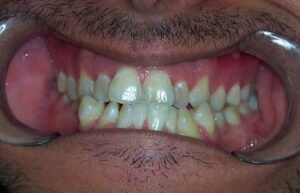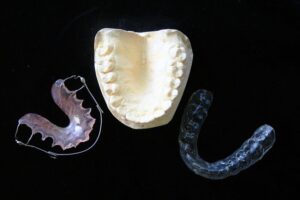What Causes Crooked Teeth?
 Many people wonder why they have crooked or crowded teeth. These orthodontic problems can have one or more contributing factors. In this article, we will cover some of the reasons people have crooked teeth.
Many people wonder why they have crooked or crowded teeth. These orthodontic problems can have one or more contributing factors. In this article, we will cover some of the reasons people have crooked teeth.
Small Jaws
When we say “small jaws”, we specifically refer to the length and width of the dental arch. A dental arch is the U-shaped jawbone holding and supporting the teeth. An undersized dental arch may result from a genetic predisposition (does everyone in your family have small jaws and crooked teeth?), a growth deficiency, or airway issues.
It is best to “catch” the orthodontic problem of an undersized dental arch at a young age, while there is still growth potential. This early detection allows the dentist to intervene with orthodontic treatment aimed at stimulating and guiding growth of the jaws. If an undersized jaw is the cause of teeth crowding, and the patient is fully grown, treatment is much more complicated.
One exciting new development from Invisalign technology is a treatment called “Invisalign First”, which allows Dr. Ann to intervene earlier than ever before with clear aligners.
Large Teeth
 Some people have teeth that are larger than the average size. In the best-case scenario, the size of a person’s teeth is proportional to the size of the face and jaws. However, in some cases, the jaws are a normal size, and the teeth are disproportionately large. This makes it impossible for these teeth to come into the mouth in the correct alignment. They have to twist sideways or move forwards or backwards to fit into the mouth, leading to rotated and misplaced teeth.
Some people have teeth that are larger than the average size. In the best-case scenario, the size of a person’s teeth is proportional to the size of the face and jaws. However, in some cases, the jaws are a normal size, and the teeth are disproportionately large. This makes it impossible for these teeth to come into the mouth in the correct alignment. They have to twist sideways or move forwards or backwards to fit into the mouth, leading to rotated and misplaced teeth.
It is possible to reduce the size of teeth and create space for alignment. Sometimes it is necessary to remove (extract) one or more permanent teeth in order to make room for the others to straighten.
Premature Loss of Baby Teeth
The baby teeth serve an important purpose in holding space in the dental arches for the future permanent teeth. When someone loses a baby tooth early, whether due to an injury or dental infection, the underlying permanent tooth may lose its space. The neighboring baby teeth will often shift or “collapse” into the newly opened space.
The earlier a baby tooth is lost, the more likely the patient is to lose the space it had been holding. The teeth could shift so drastically that the permanent tooth is unable to come into the mouth at all. This is called “impaction”. Basically, the loss of space prevents the new tooth from moving into its proper space.
More often, the lack of space will cause the permanent tooth to shift its movement to a path of less resistance. This means it could come in on the outside of the crowded baby teeth toward the cheek or on the inside toward the tongue.
The great news is that this orthodontic problem is preventable! If your child loses a baby tooth earlier than he should, your dentist can hold the space open with a simple appliance known as a space maintainer. This appliance prevents shifting of the neighboring baby teeth and saves the seat for the incoming permanent tooth.
Breathing Problems
Many people are surprised by this one. Airway issues are a common cause of orthodontic crowding. Patients who have nasal obstructions (they can’t breathe through their noses) commonly breathe through the mouth. This constant posture of an open mouth, especially during growth phases, has a narrowing effect on the upper jaw. Often it causes a very high vaulted palate (roof of the mouth) and a constricted dental arch. This limits the amount of space for teeth to come in, causing crowding.
It is important for your dentist to recognize particular habits (like mouth breathing) and growth patterns in children as early as possible in order to intervene orthodontically. We can effectively widen the upper dental arch with a palatial expander as long as the child still has growth potential.
Orthodontic Relapse
 Many people are frustrated by this common situation: they underwent orthodontic treatment, achieved a perfectly straight smile, and then suffered relapse. The teeth slowly returned to their crowded, crooked alignment. This is extremely common. It is also the reason your dentist and orthodontist tell you that you must wear your retainers.
Many people are frustrated by this common situation: they underwent orthodontic treatment, achieved a perfectly straight smile, and then suffered relapse. The teeth slowly returned to their crowded, crooked alignment. This is extremely common. It is also the reason your dentist and orthodontist tell you that you must wear your retainers.
How long do you need to wear orthodontic retainers? Only as long as you want your teeth to be straight . . .
Teeth have a natural tendency to return to their pre-orthodontic treatment position. If you do not actively retain them in their newly straightened position, they will passively move back to their misaligned position.
Aging
While most of the previous causes described here occur during childhood, this one stands alone as a uniquely adult cause of crooked teeth. It is simply a natural part of the aging process for teeth to move forward in the mouth.
Over years and years of use, our teeth suffer loss of enamel from friction where they touch their neighbors (where you floss). This microscopic enamel loss causes a tiny gap between the teeth. The teeth shift and move over time to close these gaps, pushing forward. All of this forward movement leads to crowding in the front of the mouth.
This is a process that occurs whether or not the person had orthodontic treatment in the past. It’s the natural aging process, and the only “tooth” it does not affect is a dental implant. (This can lead to the opposite problem of gaps or spaces in front of dental implants as the other teeth move forward, and it does not.)
More Questions about Crooked Teeth?
Regardless of the cause, the solution is orthodontic treatment. If you have crooked teeth that you want to straighten, call Designer Smiles today to schedule a consultation with Dr. Ann. She is an expert in orthodontic cases, treating them with Invisalign or working with an orthodontic to provide traditional treatment with brackets and wires.
